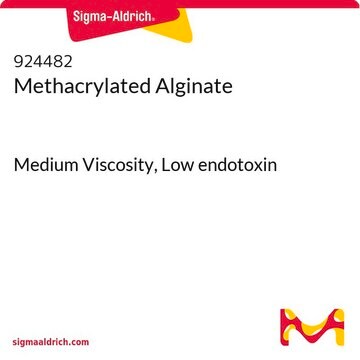913057
Alginate methacrylate
average degree of methacrylation 25%
Synonym(s):
AlMA, AlginateMA, Alginte, Methacrylate-modified alginate, Methacrylated alginate
Sign Into View Organizational & Contract Pricing
All Photos(1)
About This Item
Linear Formula:
(C13H17O10Na)m(C6H7O7Na)n
UNSPSC Code:
12352201
NACRES:
NA.23
Recommended Products
Quality Level
form
(Powder or chunk(s) or fibers)
color
light yellow
suitability
conforms to structure for NMR
storage temp.
−20°C
Looking for similar products? Visit Product Comparison Guide
Related Categories
Application
Alginate is an anionic polysaccharide that is widely used in pharmaceutical and biomedical applications due to its non-animal origin, low toxicity, biocompatibility, and biodegradability. Alginate hydrogels are commonly used to fabricate tissue engineering scaffolds, bioinks for 3D bioprinting, and nanocarriers for drug & gene delivery. While alginate is commonly crosslinked into a hydrogel via ionic-crosslinking with divalent cations (e.g., Ca2+), these gels feature limited long-term stability due to exchange reactions and migration of divalent cations from the alginate matrix. To prevent matrix degradation, alginate can be functionalized with reactive groups that can be chemically crosslinked, such as methacrylates. Methacrylate-functionalized alginate can be used to prepare hydrogels by thermal or photochemical crosslinking of the terminal methacrylates. Properties of the resulting hydrogel (e.g., stiffness, swelling ratio, rate of degradation) can be tuned by alginate molecular weight, degree of methacrylate functionalization, and crosslink density.
Storage Class Code
11 - Combustible Solids
WGK
WGK 3
Flash Point(F)
Not applicable
Flash Point(C)
Not applicable
Certificates of Analysis (COA)
Search for Certificates of Analysis (COA) by entering the products Lot/Batch Number. Lot and Batch Numbers can be found on a product’s label following the words ‘Lot’ or ‘Batch’.
Already Own This Product?
Find documentation for the products that you have recently purchased in the Document Library.
Photocrosslinkable polysaccharides for in situ hydrogel formation
Journal of Biomedical Materials Research Part A, 54 (1), 115-112 (2001)
Alginate derivatization: A review of chemistry, properties and applications
Biomaterials, 33, 3279-3305 (2012)
Oju Jeon et al.
Biomaterials, 30(14), 2724-2734 (2009-02-10)
Photocrosslinked and biodegradable alginate hydrogels were engineered for biomedical applications. Photocrosslinkable alginate macromers were prepared by reacting sodium alginate and 2-aminoethyl methacrylate in the presence of 1-ethyl-3-(3-dimethylaminopropyl)-carbodiimide hydrochloride and N-hydroxysuccinimide. Methacrylated alginates were photocrosslinked using ultraviolet light with 0.05% photoinitiator.
Jia Jia et al.
Acta biomaterialia, 10(10), 4323-4331 (2014-07-08)
Recent advances in three-dimensional (3-D) printing offer an excellent opportunity to address critical challenges faced by current tissue engineering approaches. Alginate hydrogels have been used extensively as bioinks for 3-D bioprinting. However, most previous research has focused on native alginates
Eneko Axpe et al.
International journal of molecular sciences, 17(12) (2016-11-30)
Three-dimensional (3D) bioprinting is on the cusp of permitting the direct fabrication of artificial living tissue. Multicellular building blocks (bioinks) are dispensed layer by layer and scaled for the target construct. However, only a few materials are able to fulfill
Our team of scientists has experience in all areas of research including Life Science, Material Science, Chemical Synthesis, Chromatography, Analytical and many others.
Contact Technical Service








